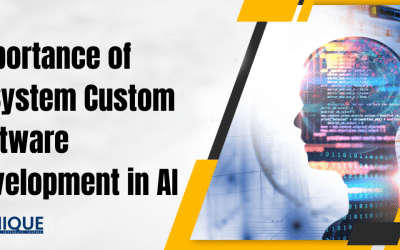If we look back at the software quality assurance process since the introduction of agile into the equation, we’ll discover that the delivery methods have transformed. Before the advent of agile practices in mobile applications, it was typical for long or bi-monthly releases. Since agile is in place, apps have adopted the form of bi-weekly, weekly releases. Frequently scheduled build updates and continuous testing came to life to ensure Custom Software Solutions releases were on time. Also, automated suits were designed to ensure sanity and regression testing—the new approach to testing allowed for rapid delivery times and faster testing tests.
With the world heading towards digital transformation, predicting market demands before time is required. The need to design a flexible and reliable infrastructure to support the future of technology is reaching its zenith. Therefore, moving away from continuous testing is a must. Artificial intelligence’s role in enhancing quality control will help us reach that goal. Companies need to change how they conduct the quality assurance process. There are two main reasons for keeping high-quality assurance services. The first is the agility of the way tests are performed (i.e., continuous quality control) and the launch speed. For QA testers to remain on top of the rapid approach to development, more than traditional testing is needed, making AI testing a necessity.
However, before we discuss how AI influences testing quality, it is essential to understand the meaning of AI in Quality Assurance and why it is crucial for companies.
What Is AI In Quality Assurance?
Artificial intelligence is a technologically friendly invention that has revolutionized industries with enormous advantages and potential. It affects the quality assurance procedure, which involves creating testing data sets and other evidence to assess the quality of software or systems with automation. This is to streamline the software development process. Humans naturally have biases, particularly in quality tests that are done manually. This increases the risk of human mistakes, which adds expense and takes longer. This problem is evident when apps are designed and implemented across several platforms.
AI will help Custom Software Development Company overcome this challenge and speed up the testing process without involvement. It can predict clients’ behavior, detect fraudulent behavior that cannot be detected with functional conventional tests, and aid with targeted marketing by replicating the manual process. This eliminates overlaps between test coverage, optimizes the automation of tests, and improves predictability and agility through self-learning. The QA team can use AI tests to enhance testing efficiency with less speed and better accuracy.
Role Of Artificial Intelligence In Quality Assurance
AI helps to make Quality Assurance processes leaner and more effective. Various AI methods and approaches have been applied to QA, including the time spent testing, ensuring that the test is covered completely, and focusing more on defect hubs. Eventually speeding up the release process for a faster timeline to launch. AI testing tools AI testing instruments can assist in conducting tests using AI-powered confirmations that provide different results.
Companies are already employing AI to conduct tests using images, AI spidering, monitoring API tests, and automated test tasks. When artificial intelligence becomes widely used, testers will find it much easier and faster to design test cases, run them, and then analyze tests for software without making manual updates. In addition, they’ll quickly identify control issues and the connection between software and defects. The significance of AI for automated quality assurance can be observed through testing tools that enhance the test with AI-powered visual verification, which, in turn, provides various possible results. Quality assurance specialists should expect an increasingly exploratory experience from machine learning and AI quality control technologies as part of their toolboxes.
Areas In Which AI Will Significantly Assist In QA procedures:
Test Automation And Virtual Assistants
Chatbots powered by AI, such as Copilot and ChatGPT, simplify communication, streamline repetitive tasks, and immediately support QA engineers and other key stakeholders. These tools speed up testing automation and improve cooperation and efficiency in QA teams.
Test Data Generation And Test Case Management
AI tools like ChatGPT excel at generating test data, dealing with multilingual scenarios, and creating and managing test scenarios. They can even assist in formulating QA plans (e.g., Tricentis Tosca, TestRail). Utilizing AI abilities, QA teams can optimize their testing processes and provide complete test coverage.
Skill Enhancement And Communication
AI platforms such as ChatGPT and Perplexity.ai enable QA professionals to increase their understanding, get advice on various topics, and collaborate on projects involving coding (e.g., GitHub, Jira). Furthermore, AI facilitates effective communication with colleagues and clients by facilitating the efficient and quick sharing of fresh ideas.
Advanced Testing Techniques
AI can enable Test Case Prioritization based on variables like code changes and risk assessment, allowing QA teams to concentrate on areas of most significant importance. Intelligent test execution dynamically optimizes test suites, resulting in more efficient testing and resource use.
Continuous Improvement And Anomaly Detection
Through integrating AI into CI/CD pipelines, QA teams can review the creation of artifacts, spot anomalies, and identify deviations earlier during the development process (e.g., Jenkins, Travis CI). Predictive analytics driven by AI predict software errors and performance problems, which allows proactive strategies to mitigate risk.
Actionable Insights And Reporting
Analytics dashboards powered by AI provide invaluable insight into software quality metrics, such as defects, test coverage, and release readiness. They empower QA teams to make informed choices and ensure continuous improvements in quality assurance processes.
Benefits Of Using AI In QA And Testing
The testing tool, powered by AI, mimics human behavior and enables testers to shift beyond the manual testing method to an automated, precise, continuous testing procedure. With that in mind, there are some essential benefits to using AI for Testing and QA. We’ll dive into it!
Test Fatigue Can Be Reduced
AI to improve quality assurance could save you approximately 60% of your time and efforts because it eliminates duplicate test cases and repeat tests for regression and smoke tests, enabling you to be more productive. Based on the level of risk detected through machine learning algorithms used to assess the function being tested, AI provides analysis of the testing scenarios that should be run.
Long-Term Traceability
Indicating the complexity of the business’s objectives, functions, and weaknesses helps in the decision-making procedure. It is directly connected to the release management function. It improves customer satisfaction by ensuring the product goes into the market with no weaknesses. It also has an automatic feature built into the product that provides complete coverage and certainty.
Control Of Procedures For Business
In confirming the particular features and capabilities, AI ensures that applications and services meet consumer and business requirements. Additionally, AI analyzes the most critical operations throughout the company and graphically maps the risk to the service or application on an enumeration of risks. This dashboard provides a comprehensive picture of risks and vulnerabilities in a company’s business operations. Predicting weak spots
AI assists in predicting areas of failure and provides engineers insight into the functions that require more excellent testing. Additionally, AI delivers insights based on past incidents for the test application by analyzing production data and previous project experience.
Release Of Well-Studied Builds
Artificial intelligence allows AI developers to evaluate different software and apps to discover the factors that led to their success on the market. Additionally, tests can be developed following the identification of market requirements to ensure that the app or program isn’t broken to meet specific targets.
Effortless Test Designing
Most quality assurance professionals’ work can be categorized as testing the design of scenarios. The same method must be followed every time the most recent version launches. AI QA automation solutions may aid testers with the development of scripts with less code or a low level of automated test scripts. It analyzes the application by scrolling across each page before creating and running tests for these.
Extended Timelines
There are a variety of ways that a group of developers can accelerate the application and development of software. Integrating interruptions into the process of testing is just one. Instead of sifting through many codes, AI can analyze logs, look through the codes, and identify the errors in just a few moments. Furthermore, AI lacks the burnout issue, resulting in more efficient and more precise results. Also, AI can adapt to changes in code. It will adapt to and detect new features and functions. It can also be programmable to determine whether something is a brand newly introduced feature or a problem resulting from a code change.
Writing Of Test Case Cases With Improved Writing
AI enhances the effectiveness of your test scenarios by automating testing. It provides authentic tests that are easy to use and simple to manage. The conventional method doesn’t permit developers to consider the possibilities of testing situations. Using AI in quality control, the analysis of project data takes less than a minute. Consequently, it allows the programmers to develop new strategies for testing cases.
Visual User Interface Testing
AI assists in improving the user interface design and the visually endorsed website pages. AI can test various content within the user interface. The tests are hard to implement and usually require the intervention of a human to make an informed decision on layout. With ML-based visualization software, images’ contrasts can be seen in a manner that is impossible to identify. AI testing eliminates manual labor in modernizing this Document Object Model (DOM), creating a structure, and analyzing the risks.
Enhanced Defect Tracking
When testing manually and conventionally, mistakes and bugs can go undetected for an extended period and cause problems that could become problems soon. AI is used in software testing to find flaws automatically. As software develops, the amount of data increases, which means the number of bugs discovered increases. AI can detect these bugs rapidly and efficiently so software developers can work efficiently. AI-based bug tracking detects the presence of duplicate errors and can identify fingerprints of problems.
Limitations Of Manual Testing And How AI Can Change That
The purpose of using AI for Quality Assurance is to eliminate the limitations of manual testing. Manual testing can be a lengthy method susceptible to human errors. Creating, organizing, performing test scenarios, writing down the results, and confirming them is a significant undertaking. With the increasing complexity of Custom Software Development Services, manual testing becomes more complicated and can lead to more extended tests.
Additionally, manual testing may delay finding or resolving issues, mainly when major software updates or releases occur. In the case of manual testing, the process of tests for regression, which is crucial for software maintenance, could be more efficient and productive. The costs involved in the training of new testers, as well as managing test environments, should be considered. Automation tests speed up the process by making completing repetitive and time-consuming tasks easier. As we get closer to self-contained testing, many common automated testing problems will also be possible to address.
Steps For Developing AI In Quality Assurance
AI in Quality Assurance (QA), there are essential steps for creating high-quality artificial intelligence programs, which include:
Pilot And Data Annotation
The QA team usually decides on the testing they plan to conduct and what goals they wish to achieve. Once they have established the scope and objectives of testing, QA teams should gather the necessary data. Testing methods must be affixed according to the project’s purpose and the AI methods and designs utilized in tests. This will ensure that the information used to train models is of the highest quality.
Validation And Testing Along With The Process Of Scaling
The QA team repeatedly designs testing algorithms and selects the appropriate part of the training data to test the hypothesis. They then place this training data into a test and examine the algorithm’s performance. Then, they observe the data’s behaviors and confirm whether the AI algorithm is able to predict results with accuracy and consistency or otherwise.
Retrain
Every AI model requires regular Retraining. After validating and testing the AI model’s performance in the QA test, the next thing to do is train your ML model or continually update it to keep it in tune with the current capabilities. This is to verify that the accuracy of the AI model for QA is in good order, providing the right quality of results and offering the opportunity to increase precision.
The Popular AI Testing Tools
While it isn’t perfect, quality assurance is getting a foothold in the third wave of automation thanks to AI-driven quality control platforms. Here are a few of the most influential AI testing tools and systems available today. They will help answer the most frequently asked question: what AI tools can enhance assurance quality?
Eggplant AI
It employs intelligent algorithms to navigate the software, forecast the numerous defects, and overcome problems with sophisticated data correlation. It can also automate tests and test automation software and visually analyze the test coverage and results.
Appvance
It provides deep analysis via machine learning. It also provides “app blueprint” models that use cognition generation. The blueprints allow you to build multiple test cases within minutes. Appvance comes with Test Designer functionality that can be combined with screenshot comparators test cases, tests driven by data, and AJAX or DOM auto-capturing.
Testim.io
This software aims to use AI and machine learning to assist in the creation, execution, and monitoring of automated tests. It concentrates on functional tests that cover the entire process and the user interface. It is constantly evolving and stable, and the stability of the test suites improves with each test.
Testsigma
It’s among the most widely used AI-powered tools to continuously automate automated testing. It uses natural language processing to assist in creating high-quality auto tests. The platform also helps identify relevant tests to be used in a that is running and prevents unexpected tests from failing.
Applitools
This tool does not require creating settings for visual processing, such as percentages or settings to set up visual tests. It automatically recognizes the changes that are more likely to cause bug-related problems and which are the most desirable modifications. It then ranks differences by the criteria.
TestCraft
TestCraft is an AI-powered test automation tool for Continuous and Regression testing. TestCraft is a test automation platform that allows continuous and regression testing. TestCraft testers can create visually automated Selenium-based tests with an interface that drags drops and runs them simultaneously through various browsers and working environments.
SauceLabs
It’s robust cloud-based software that uses ML and AI. It is believed to be the largest continuously testing cloud. It provides over 900 options for browsers, operating systems, and hundreds of gadgets.
The Future of Autonomous Testing And AI In QA
The software testing industry is moving towards autonomous testing, gradually driving testing automation to the back of the pack. Automated testing was the most innovative way to test, but autonomy testing is the way we need to focus on. At present, AI-driven automated testing is only at the beginning stages. However, we can see its progress following an uptrend within the next few years. AI technology will require time to be fully educated and integrated into the established system. Therefore, it is long before businesses can truly reap the advantages of AI-driven quality control. Several interesting potential developments include:
AI-Driven Test Cases That Suggest Possible Solutions As Well As Authoring
When the AI discovers the tests the business requires and the organization, it will suggest test cases in response to those needs and, if required, create the test program independently. To accomplish this, teams must continuously provide the AI with many test sessions to allow it to grow. Automated test orchestration If the AI has access to data on an organization’s testing assets in real time, it can oversee the entire testing process and automate the test schedule by utilizing the available resources. It will also make the necessary decisions to manage testing in a complex, distributed environment.
Testing Environment Set Up
Based on the information from the system’s performance, the configuration specifications, the tests AI generates. It generates data from configuration requirements, system performance, and test case suggestions. AI will handle the setup of the test environments and streamline the process of setting them up.
The Cognitive Test Is a Great Way To Explore
The human hand was previously in charge because of its impulsive nature. AI is expected to be able to perform exploratory testing and determine issues that require focus. AI can make such decisions according to patterns of use, such as priorities for business and user behavior.
AI-Powered Visual Tests
Because automation test scripts can be prone to giving false positives in visual tests, AI-powered testing can be more effective in finding the actual visual bugs that impact the user.
The constantly changing world of the QA sector requires a constant learning attitude. Tools and methods that we use today could rapidly become outdated and render our knowledge outdated. Testing professionals must go beyond only testing testing — today, they have to be able to make use of cutting-edge technology that can transform their entire testing procedure. This would give them an enormous competitive advantage in the increasingly competitive marketplace.
Conclusion
If you are considering implementing AI for Software Product Development Quality Assurance, exploring and appreciating the numerous amazing possibilities AI can provide is key. Incorporating AI could boost effectiveness and speed and even bring some enjoyment to the process. The problem is staying up-to-date by interacting with AI news or podcasts due to the speed of how AI changes, making certain instances potentially obsolete within the span of. Continuously changing software requires careful consideration not to avoid overwhelming projects with regular adjustments, security checks, or learning curves. The task of the moment is to find and choose the most efficient tools for your work while ensuring continuity for the duration.
It is crucial to recognize that although AI could be a massive help in QA tasks, it is essential to be wary of putting too much trust in AI. Human oversight is still vital due to ongoing ethical issues like bias in data for training, privacy concerns, and the necessity of human involvement.











